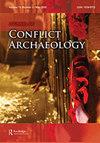战败者的形象:青铜时代晚期希腊的善终?
IF 0.6
0 ARCHAEOLOGY
引用次数: 0
摘要
参与战斗的战士是青铜时代晚期希腊的典型形象,既有胜利者,也有失败者。对早期迈锡尼人和迈锡尼人的战败者形象,以及死者的葬礼祭品的研究表明,在战斗中死亡并不被认为是一种耻辱。此外,对倒下的敌人表示尊敬可能会增强胜利者的斗志。从青铜时代晚期的希腊幸存下来的图像庆祝战争的技巧,既为胜利者,也为失败者。这些图像表明,在青铜时代晚期的希腊大陆,无论是胜利者还是失败者,在战斗中死亡都被认为是一种好的死亡。本文章由计算机程序翻译,如有差异,请以英文原文为准。
Images of the defeated: a good death in late Bronze Age Greece?
Abstract Warriors engaged in combat are characteristic images of Late Bronze Age Greece, depicting both the victors and the defeated. An examination of Early Mycenaean and Mycenaean images of the defeated, and of the presentation of the deceased by their funerary offerings, suggests that a death in battle was not perceived as a disgrace. Furthermore, a display of respect towards the fallen enemy may have enhanced the victor. The surviving images from Late Bronze Age Greece celebrate skill in warfare, both for the victor and also for the defeated. The images suggest that death in battle was considered to be a good death throughout the Late Bronze Age on the Greek mainland, whether victor or loser.
求助全文
通过发布文献求助,成功后即可免费获取论文全文。
去求助
来源期刊

Journal of Conflict Archaeology
ARCHAEOLOGY-
CiteScore
0.80
自引率
50.00%
发文量
8
期刊介绍:
The Journal of Conflict Archaeology is an English-language journal devoted to the battlefield and military archaeology and other spheres of conflict archaeology, covering all periods with a worldwide scope. Additional spheres of interest will include the archaeology of industrial and popular protest; contested landscapes and monuments; nationalism and colonialism; class conflict; the origins of conflict; forensic applications in war-zones; and human rights cases. Themed issues will carry papers on current research; subject and period overviews; fieldwork and excavation reports-interim and final reports; artifact studies; scientific applications; technique evaluations; conference summaries; and book reviews.
 求助内容:
求助内容: 应助结果提醒方式:
应助结果提醒方式:


